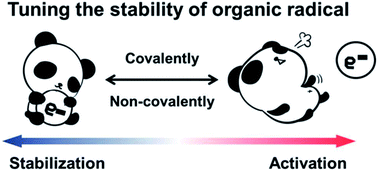Tuning the stability of organic radicals: from covalent approaches to non-covalent approaches
Abstract
Organic radicals are important species with single electrons. Because of their open-shell structure, they are widely used in functional materials, such as spin probes, magnetic materials and optoelectronic materials. Owing to the high reactivity of single electrons, they often serve as a key intermediate in organic synthesis. Therefore, tuning the stability of radicals is crucial for their functions. Herein, we summarize covalent and non-covalent approaches to tune the stability of organic radicals through steric effects and tuning the delocalization of spin density. Covalent approaches can tune the stability of radicals effectively and non-covalent approaches benefit from dynamicity and reversibility. It is anticipated that the further development of covalent and non-covalent approaches, as well as the interplay between them, may push the fields forward by enriching new radical materials and radical mediated reactions.

- This article is part of the themed collections: Editor’s Choice – Jinlong Gong, Most popular 2019-2020 review articles, Editor’s Choice – Ning Jiao, In celebration of Chinese New Year and Most popular 2019-2020 supramolecular chemistry articles


 Please wait while we load your content...
Please wait while we load your content...